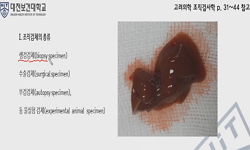Aural rehabilitation is defined as a comprehensive service which includes hearing aid fitting, hearing aid orientation, auditory training, and informational/educational counseling for people with hearing loss in order to reduce deficits of auditory fu...
http://chineseinput.net/에서 pinyin(병음)방식으로 중국어를 변환할 수 있습니다.
변환된 중국어를 복사하여 사용하시면 됩니다.
- 中文 을 입력하시려면 zhongwen을 입력하시고 space를누르시면됩니다.
- 北京 을 입력하시려면 beijing을 입력하시고 space를 누르시면 됩니다.

웹 기반 청능훈련 프로그램의 근접 분석: Toward Listening and Customized Learning Exercises for Aural Rehabilitation를 중심으로 = Proximity Analysis of Web-Based Auditory Training Programs: Toward Listening and Customized Learning Exercises for Aural Rehabilitation
한글로보기https://www.riss.kr/link?id=A106834696
- 저자
- 발행기관
- 학술지명
- 권호사항
-
발행연도
2018
-
작성언어
Korean
- 주제어
-
등재정보
KCI등재
-
자료형태
학술저널
- 발행기관 URL
-
수록면
167-176(10쪽)
-
KCI 피인용횟수
0
- DOI식별코드
- 제공처
- 소장기관
-
0
상세조회 -
0
다운로드
부가정보
다국어 초록 (Multilingual Abstract)
Aural rehabilitation is defined as a comprehensive service which includes hearing aid fitting, hearing aid orientation, auditory training, and informational/educational counseling for people with hearing loss in order to reduce deficits of auditory function, difficulty in communication, and limited social activity, and ultimately to enhance their quality of life. Although it is well known that auditory training among a large scope of the aural rehabilitation is critical to improve residual hearing of hearing-impaired adults and/or older adults, there are some limitations to conduct it in the clinic in terms of time consuming and individual difference. In this review paper, we introduce two of the most popular web-based auditory training programs, namely Listening and Communication Enhancement And customized learning: Exercises for Aural Rehabilitation. The paper analyzes their purpose, contents, effect (or benefit) of auditory training, and clinical application, while arguing their pros and cons. In conclusion, we discuss a necessary of developing auditory training platforms for the hearing-impaired adults and older adults, and then of forging systematic web-based auditory training tools with a low-cost and high efficiency because aging population is rapidly increasing in Korea.
참고문헌 (Reference)
1 이영미, "청각장애 아동의 청각기억 향상을 위한 모바일 어플리케이션 개발" 한국청각언어재활학회 13 (13): 50-61, 2017
2 유재형, "스마트폰 청능훈련 어플리케이션을 이용한 난청 성인의 어음인지능력 향상에 관한 사례 연구" 한국청각언어재활학회 10 (10): 158-168, 2014
3 Henderson Sabes J, "Variables predicting outcomes on listening and communication enhancement (LACETM) training" 46 (46): 374-383, 2007
4 Tye-Murray N, "Using patient perceptions of relative benefit and enjoyment to assess auditory training" 23 (23): 623-634, 2012
5 Rao A, "Training the brain: hearing aids and ReadMyQuips"
6 Ciuffreda KJ, "The scientific basis for and efficacy of optometric vision therapy in nonstrabismic accommodative and vergence disorders" 73 (73): 735-762, 2002
7 Sweetow RW, "The need for and development of an adaptive listening and communication enhancement (LACE) program" 17 (17): 538-558, 2006
8 Ventry IM, "The hearing handicap inventory for the elderly: a new tool" 3 (3): 128-134, 1982
9 Sommers MS, "The effects of meaning-based auditory training on behavioral measures of perceptual effort in individuals with impaired hearing" 36 (36): 263-272, 2015
10 Pichora-Fuller MK, "The design of CAST (computeraided speechreading training)" 34 (34): 202-212, 1991
1 이영미, "청각장애 아동의 청각기억 향상을 위한 모바일 어플리케이션 개발" 한국청각언어재활학회 13 (13): 50-61, 2017
2 유재형, "스마트폰 청능훈련 어플리케이션을 이용한 난청 성인의 어음인지능력 향상에 관한 사례 연구" 한국청각언어재활학회 10 (10): 158-168, 2014
3 Henderson Sabes J, "Variables predicting outcomes on listening and communication enhancement (LACETM) training" 46 (46): 374-383, 2007
4 Tye-Murray N, "Using patient perceptions of relative benefit and enjoyment to assess auditory training" 23 (23): 623-634, 2012
5 Rao A, "Training the brain: hearing aids and ReadMyQuips"
6 Ciuffreda KJ, "The scientific basis for and efficacy of optometric vision therapy in nonstrabismic accommodative and vergence disorders" 73 (73): 735-762, 2002
7 Sweetow RW, "The need for and development of an adaptive listening and communication enhancement (LACE) program" 17 (17): 538-558, 2006
8 Ventry IM, "The hearing handicap inventory for the elderly: a new tool" 3 (3): 128-134, 1982
9 Sommers MS, "The effects of meaning-based auditory training on behavioral measures of perceptual effort in individuals with impaired hearing" 36 (36): 263-272, 2015
10 Pichora-Fuller MK, "The design of CAST (computeraided speechreading training)" 34 (34): 202-212, 1991
11 Sweetow R, "The communication confidence profile: a vital, but overlooked subjective domain" 63 (63): 17-18, 2010
12 Sweetow RW, "The case for LACE: listening and auditory communication enhancement training" 57 (57): 32-35, 2004
13 Cronin B, "The DAVID system: the development of an interactive video system at the National Technical Institute for the Deaf. A pilot experiment in computer assisted speechreading instruction utilizing the data analysis video interactive device (DAVID)" 124 (124): 616-623, 1979
14 Barcroft J, "Task-and talkerspecific gains in auditory training" 59 (59): 862-870, 2016
15 Martin M, "Software-based auditory training program found to reduce hearing aid return rate" 60 (60): 32-34, 2007
16 Warren E, "Over-the-counter hearing aids: the path forward" 177 (177): 609-610, 2017
17 Sarampalis A, "Objective measures of listening effort: effects of background noise and noise reduction" 52 (52): 1230-1240, 2009
18 Kochkin S, "MarkeTrak VIII: 25-year trends in the hearing health market" 16 (16): 12-31, 2009
19 Parker BJ, "MacAid: computer application in aural rehabilitation" 26 : 13-23, 1993
20 Gunther VK, "Long-term improvements in cognitive performance through computer-assisted cognitive training: a pilot study in a residential home for older people" 7 (7): 200-206, 2003
21 Tye-Murray N, "Gaming technology for customized aural rehabilitation and hearing healthcare" 23 (23): 20-, 2016
22 Miranda EC, "Formal auditory training in elderly hearing aid users" 74 (74): 919-925, 2008
23 Gil D, "Formal auditory training in adult hearing aid users" 65 (65): 165-174, 2010
24 Sweetow R, "Efficacy of individual auditory training in adults: a systematic review of the evidence" 16 (16): 494-504, 2005
25 Kricos PB, "Efficacy of audiologic rehabilitation for older adults" 7 (7): 219-229, 1996
26 Hawkins DB, "Effectiveness of counseling-based adult group aural rehabilitation programs: a systematic review of the evidence" 16 (16): 485-493, 2005
27 Sprinzl GM, "Current trends in treating hearing loss in elderly people: a review of the technology and treatment options - a mini-review" 56 (56): 351-358, 2010
28 Tye-Murray N, "Computerized laser videodisc programs for training speechreading and assertive communication behaviors" 21 : 143-152, 1988
29 Dempsey JJ, "Computer-assisted tracking simulations (CATS)" 92 (92): 701-710, 1992
30 Fu QJ, "Computer-assisted speech training for cochlear implant patients: feasibility, outcomes, and future directions" 28 (28): 1-11, 2007
31 Boothroyd A, "CasperSent: a program for computer-assisted speech perception testing and training at the sentence level" 41 : 31-52, 2008
32 Boothroyd A, "CASPER, computer-assisted speech-perception evaluation and training" Association for Advancement of Rehabilitation Technology 734-736, 1987
33 Prendergast SG, "Aural rehab services: survey reports who offers which ones and how often, and by whom" 55 (55): 30-35, 2002
34 Tye-Murray N, "Auditory training with frequent communication partners" 59 (59): 871-875, 2016
35 Sweetow RW, "Auditory training and challenges associated with participation and compliance" 21 (21): 586-593, 2010
36 Gagne JP, "An evaluation of CAST: a computeraided speechreading training program" 34 (34): 213-221, 1991
37 Tye-Murray N, "An auditory training game program can help you customize care for your patients" 21 (21): 18-19, 2016
38 Boothroyd A, "Adult aural rehabilitation: what is it and does it work?" 11 (11): 63-71, 2007
동일학술지(권/호) 다른 논문
-
측두골 3차원 영상과 외이도성형술로 제거된 외이도 내 시멘트 조각 1예
- 대한이비인후과학회
- 김민재
- 2018
- KCI등재
-
이개에 발생한 기저편평세포암의 치료에서 Mohs 미세도식수술의 적용
- 대한이비인후과학회
- 이근익
- 2018
- KCI등재
-
Epstein-Barr Virus와 연관되어 발생한 비인두와 비강의 동시성 이중원발암 1예
- 대한이비인후과학회
- 선상우
- 2018
- KCI등재
-
- 대한이비인후과학회
- 서인효
- 2018
- KCI등재
분석정보
인용정보 인용지수 설명보기
학술지 이력
| 연월일 | 이력구분 | 이력상세 | 등재구분 |
|---|---|---|---|
| 2024 | 평가예정 | 해외DB학술지평가 신청대상 (해외등재 학술지 평가) | |
| 2021-04-14 | 학술지명변경 | 한글명 : 대한이비인후과학회지 두경부외과학 -> 대한이비인후-두경부외과학회지외국어명 : Korean Journal of Otorhinolaryngology Head and Neck Surgery -> Korean Journal of Otorhinolaryngology-Head and Neck Surgery |  |
| 2021-01-01 | 평가 | 등재학술지 유지 (해외등재 학술지 평가) |  |
| 2020-01-01 | 평가 | 등재학술지 유지 (재인증) |  |
| 2017-01-01 | 평가 | 등재학술지 유지 (계속평가) |  |
| 2015-01-01 | 평가 | 등재학술지 유지 (등재유지) |  |
| 2011-01-01 | 평가 | 등재학술지 유지 (등재유지) |  |
| 2009-06-12 | 학술지명변경 | 외국어명 : Korean Journal of Otolaryngology-Head and Neck Surgery -> Korean Journal of Otorhinolaryngology Head and Neck Surgery |  |
| 2009-01-01 | 평가 | 등재학술지 유지 (등재유지) |  |
| 2007-06-14 | 학회명변경 | 영문명 : Korean Society Of Otolaryngology -> Korean Society of Otorhinolaryngology-Head and Neck Surgery |  |
| 2007-01-01 | 평가 | 등재학술지 유지 (등재유지) |  |
| 2006-01-16 | 학술지명변경 | 외국어명 : Korean Journal of Otolaryngology-Head &N -> Korean Journal of Otolaryngology-Head and Neck Surgery |  |
| 2005-01-01 | 평가 | 등재학술지 유지 (등재유지) |  |
| 2002-01-01 | 평가 | 등재학술지 선정 (등재후보2차) |  |
| 1999-07-01 | 평가 | 등재후보학술지 선정 (신규평가) |  |
학술지 인용정보
| 기준연도 | WOS-KCI 통합IF(2년) | KCIF(2년) | KCIF(3년) |
|---|---|---|---|
| 2016 | 0.12 | 0.12 | 0.13 |
| KCIF(4년) | KCIF(5년) | 중심성지수(3년) | 즉시성지수 |
| 0.12 | 0.13 | 0.306 | 0.02 |




 KCI
KCI






